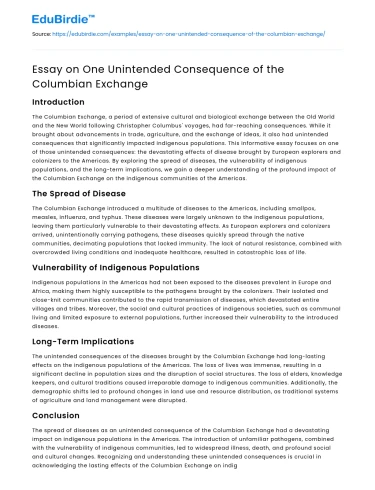Introduction
The Columbian Exchange, a period of extensive cultural and biological exchange between the Old World and the New World following Christopher Columbus' voyages, had far-reaching consequences. While it brought about advancements in trade, agriculture, and the exchange of ideas, it also had unintended consequences that significantly impacted indigenous populations. This informative essay focuses on one of those unintended consequences: the devastating effects of disease brought by European explorers and colonizers to the Americas. By exploring the spread of diseases, the vulnerability of indigenous populations, and the long-term implications, we gain a deeper understanding of the profound impact of the Columbian Exchange on the indigenous communities of the Americas.
The Spread of Disease
The Columbian Exchange introduced a multitude of diseases to the Americas, including smallpox, measles, influenza, and typhus. These diseases were largely unknown to the indigenous populations, leaving them particularly vulnerable to their devastating effects. As European explorers and colonizers arrived, unintentionally carrying pathogens, these diseases quickly spread through the native communities, decimating populations that lacked immunity. The lack of natural resistance, combined with overcrowded living conditions and inadequate healthcare, resulted in catastrophic loss of life.
Save your time!
We can take care of your essay
- Proper editing and formatting
- Free revision, title page, and bibliography
- Flexible prices and money-back guarantee
Vulnerability of Indigenous Populations
Indigenous populations in the Americas had not been exposed to the diseases prevalent in Europe and Africa, making them highly susceptible to the pathogens brought by the colonizers. Their isolated and close-knit communities contributed to the rapid transmission of diseases, which devastated entire villages and tribes. Moreover, the social and cultural practices of indigenous societies, such as communal living and limited exposure to external populations, further increased their vulnerability to the introduced diseases.
Long-Term Implications
The unintended consequences of the diseases brought by the Columbian Exchange had long-lasting effects on the indigenous populations of the Americas. The loss of lives was immense, resulting in a significant decline in population sizes and the disruption of social structures. The loss of elders, knowledge keepers, and cultural traditions caused irreparable damage to indigenous communities. Additionally, the demographic shifts led to profound changes in land use and resource distribution, as traditional systems of agriculture and land management were disrupted.
Conclusion
The spread of diseases as an unintended consequence of the Columbian Exchange had a devastating impact on indigenous populations in the Americas. The introduction of unfamiliar pathogens, combined with the vulnerability of indigenous communities, led to widespread illness, death, and profound social and cultural changes. Recognizing and understanding these unintended consequences is crucial in acknowledging the lasting effects of the Columbian Exchange on indigenous communities and working towards a more inclusive and equitable future.






 Stuck on your essay?
Stuck on your essay?

